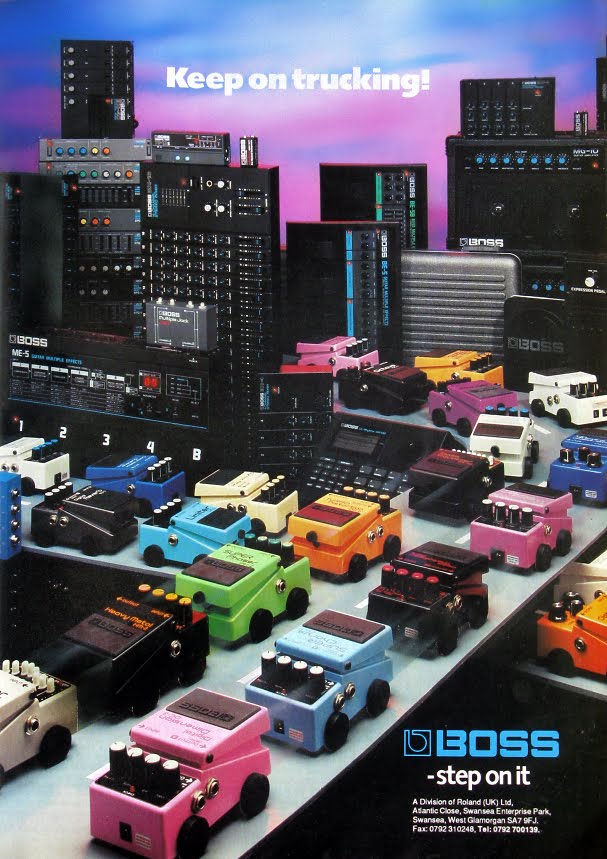
There was a lot going on in the world of music technology in late 1983, but not everyone had been bitten by the new MIDI bug. Those who still wanted unprecedented dirt rather than the novelty of sterilised synthiness, had a friend in Boss, who, with their brand new HM-2 Heavy Metal stomp box, were going all out to impress the budding gods of rawk 'n' roll...
The Boss Heavy Metal was interesting in that its circuit was derived not from the DS-1 Distortion, but from the much milder and more natural-sounding OD-1 Overdrive. Part of Boss’s original brief was to maintain the characteristics of the guitar rather than simply clipping it into oblivion, and despite other major selling points such as the high gain and special tone-shaping, they always incorporated the ‘natural’ distortion model into the HM-2’s marketing blurb.
This made me wonder whether the design initially set out in a completely different direction, and only ended up in heavy metal territory by accident? Afterall, the heavy metal guitarists of the early ‘80s weren’t greatly concerned about preserving the subtle personality of their clean guitar tone. Indeed, most of them seemed to want the exact opposite. Mind you, some heavy rock players apparently did use OD-1s as part of their setups before the HM-2 was introduced, so maybe Boss thought it was significant enough a component to use as a jumping-off point. Anyway, whether or not Boss did originally intend the HM-2 to end up as it did, the product appealed to a much wider customer base than just the hard rock fans. It could be used for heavy metal, but it didn’t have to be. I didn’t play any heavy metal, but I still chose the HM-2 as my first Boss pedal, and my primary distortion unit for gigs and recording.
A major departure from typical distortion units of the day was the HM-2’s use of a split-band tone section, rather than a simple, single treble roll-off knob. Color Mix, as the HM-2 termed this combination of tone-shaping controls, was not a straight bass/treble arrangement. Color Mix L (L for Low) added or subtracted bass, but Color Mix H (H for High) in fact added or subtracted midrange, allowing anything from a seriously scooped rumble to an overtly middly singing lead. The unit’s other two knobs were a predictable Level and Dist(ortion), which did as you’d expect – the Dist offering a very considerable amount of gain.
But despite the versatility of the HM-2, its distortion wasn’t particularly smooth. I found it benefitted from being fed into an already overdriven channel on a valve amp – just to blur the slightly fuzz-orientated ‘gravel’. I used to do that with a Peavey Deuce amp in the mid ‘80s, and it definitely improved the effect. However, the lack of a dedicated treble control (a proper treble control, which removed fizzy highs rather than scooping the mids) made the HM2 difficult to work with in my view. Obviously, you could take down the treble on your amp, but then your clean sound lost its sparkle when you disengaged the pedal. The two-band tone section did undeniably capture the character of the early 1980s heavy metal sounds, but it left the HM-2 without a way of smoothing what was inherently a fuzzy top end.

The classic 1992 Boss 'Keep on Trucking' UK ad prominently featured the Boss HM-2 Heavy Metal pedal. Just look at some of the old memorables depicted in the photo, such as the ME-5 and the DR-660 beat box. There are even a couple of Boss batteries.
The HM-2 didn’t have the longest of lifespans as Boss pedals go. Its shortcomings were resolved in the MT-2 Metal Zone, which to a large extent took its place in the market from 1991. The HM-2 did, however, have a longer innings than the MZ-2 Digital Metalizer, which was also withdrawn in '91, but which wasn't introduced until a few years after the Heavy Metal.
It should, however, be noted that whilst the HM-2 and MZ-2 were dropped or replaced by Boss from 1991, stocks lasted for some considerable time and they both remained available new on the UK market as late as 1994. Indeed, both pedals appeared in Boss's 1992 'Keep on Trucking' magazine ad (shown above), so they were still promoted by Boss themselves even after becoming obsolete. The HM-2's successor the Metal Zone had a less fuzz-orientated sound by default, but also offered a more comprehensive way of shaping that sound, so the user would not find trying to tailor out the fizz such a frustrating experience. Nevertheless, the Boss Heavy Metal was a big achievement in its day. It typified the sense of innovation Boss were renowned for, as well as their knack for capturing the essence of what guitarists were after, and putting it in a box the size of a cream slice.
More Articles on Boss Gear
More Guitar Reviews and Retrospectives

